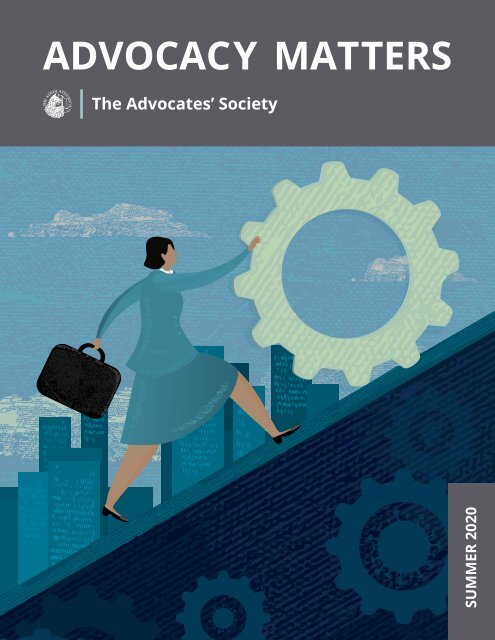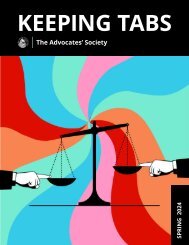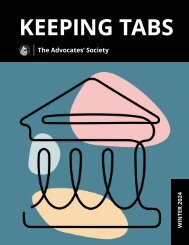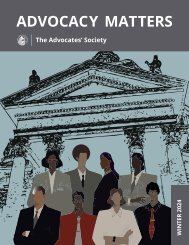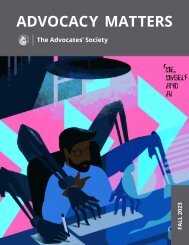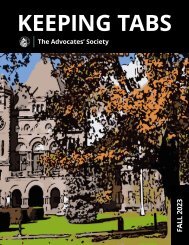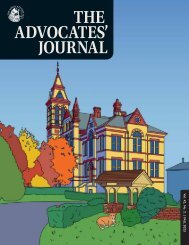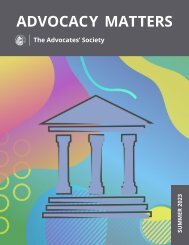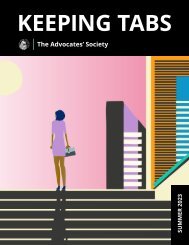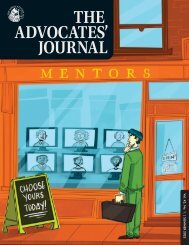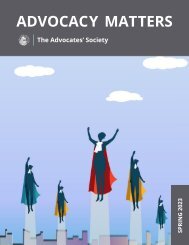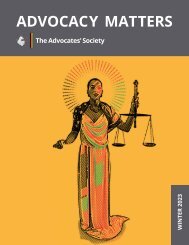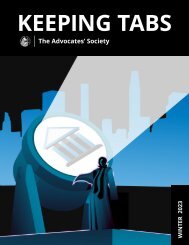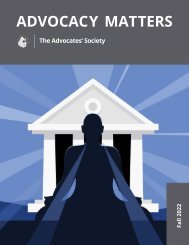Advocacy Matters - Summer 2020
Keep up to date on what your fellow Society members have to say in Advocacy Matters.
Keep up to date on what your fellow Society members have to say in Advocacy Matters.
You also want an ePaper? Increase the reach of your titles
YUMPU automatically turns print PDFs into web optimized ePapers that Google loves.
ADVOCACY MATTERS<br />
The Advocates’ Society<br />
SUMMER <strong>2020</strong>
What the TWEET is this?<br />
When you see this icon, throughout the publication,<br />
click on it to see what members are tweeting about.<br />
CONTENTS<br />
04<br />
06<br />
09<br />
12<br />
17<br />
20<br />
24<br />
Chair Chat<br />
Yola S. Ventresca, Lerners LLP<br />
TAS Report: EOT@Home<br />
Lyla Simon, Senior Enforcement Counsel,<br />
Mutual Fund Dealers Association<br />
The Justice System<br />
William Thompson, Addario Law Group LLP<br />
Quirky Cases<br />
Tamara Ramsey, Dale & Lessmann LLP<br />
Journal Review: Then and Now<br />
Christine Vanderschoot, Vanderschoot Family Law PC<br />
Interview with Owen Rees<br />
Compiled by Andrew Gibbs, Department of Justice<br />
In Conversation with Dominique Hussey<br />
Compiled by Melanie Baird, Blake, Cassels & Graydon LLP<br />
Mastering the art and craft of advocacy is a career-long commitment and we are<br />
here to help. The Advocates’ Society has been the premier provider of advocacy<br />
skills training for over 30 years. We are proud to provide lawyers across Canada<br />
with the training and the confidence they need to execute on their feet when it<br />
counts. The Judge will notice…your clients will too.<br />
Visit www.advocates.ca. Be part of the legacy of extraordinary advocates.<br />
Editor: Tamara Ramsey, Dale & Lessmann LLP (Editor)<br />
The opinions expressed by individual authors are their own and do not necessarily reflect the policies of The Advocates’ Society.<br />
<strong>Advocacy</strong> <strong>Matters</strong> Editorial Team: Andrew Gibbs, Department of Justice, Christine J. Vanderschoot, Vanderschoot Family Law, Megan Keenberg,<br />
Van Kralingen & Keenberg LLP, Daniel Baum, Langlois Avocats, S.E.N.C.R.L., Ayesha Laldin, Department of Justice, Michelle Alton, Workplace Safety<br />
and Insurance Appeals Tribunal<br />
3
CHAIR CHAT<br />
Chair Chat<br />
Yola S. Ventresca, Lerners LLP<br />
As I sit down to write my first column as Chair<br />
of the 10+ Standing Committee, much is on<br />
my mind, much is weighing me down. World<br />
events of the past six months have changed so<br />
much of life as we knew it in real and substantive<br />
ways; the legal profession has not been<br />
spared. I could go on at lengths about how<br />
this so-called ‘new normal’ has thrown the profession<br />
head first into a technological revolution<br />
or about how the pandemic has seriously<br />
strained working parents. I will save those ruminations<br />
for another day.<br />
Instead, I want to talk about another issue<br />
that is front-of-mind and in the headlines: the<br />
remarkable flourishing of the Black Lives Matter<br />
anti-racism protest movement, sparked by<br />
the brutal murder of George Floyd Jr., a Black<br />
American killed by the police after his arrest<br />
in Minneapolis in May <strong>2020</strong>.<br />
While it may be convenient for some to dismiss<br />
what is going on as a uniquely American<br />
“problem”, we in this country should not deceive<br />
ourselves. It is not simply ‘their’ problem.<br />
Canada, too, has an ugly history of anti-Black<br />
racism, one that continues to haunt us to this<br />
day. It is trite to say that systemic racism permeates<br />
all facets of society. The legal profession is<br />
not immune.<br />
It has been almost three years since the<br />
Globe & Mail published Hadiya Rodrique’s autobiographical<br />
essay, Black on Bay Street: Hadiya<br />
Rodrique had it all. But still could not fit in.<br />
In that essay, Rodrique outlines her trajectory;<br />
her childhood, her experiences as a black student<br />
and a top candidate in the ultra-competitive<br />
Toronto recruit. It would seem the closer<br />
Rodrique came to the ‘summit’ of our profession,<br />
as she puts it, the more marginalized she<br />
was made to feel. Rodrique ultimately left Bay<br />
Street for academia.<br />
Rodrique’s essay garnered much attention.<br />
It provoked a myriad of promises from all corners<br />
of the profession to do better; to be better.<br />
Yet for all these promises, it appears from<br />
the limited data available, we are not much further<br />
along, if at all. In a recent essay about Black<br />
lawyers, the Globe & Mail presented the results<br />
of its own study of sixteen of Toronto’s largest<br />
law firms. Of the 4,000 partners identified, just<br />
35 were Black. What this tells us is that of Black<br />
lawyers, a miniscule percentage are partners in<br />
firms. Most, it would seem, have to forge their<br />
own path as sole practitioners.<br />
All of this leads me back to a question that<br />
has been nagging me and many others. What<br />
can I do? In many ways, I have not yet fully answered<br />
my own question. I do know that I want<br />
to use this inaugural post to commit to working<br />
toward greater equity in the legal profession. I<br />
want to use this privileged forum to do my part,<br />
however modest, to move our profession closer<br />
to its stated commitments to do better. The 10+<br />
Standing Committee represents mid-career lawyers<br />
across Canada. We are the future leaders of<br />
the profession and members of the bench. So<br />
I would like to extend an invitation: we want to<br />
hear and to amplify the voice of racialized lawyers.<br />
If you have ideas for an article, for a TAS<br />
event, for professional development, please<br />
let us know. My DMs are open (@YolaVentresca).<br />
For now, please know that this issue is an<br />
urgent priority for us. And we are not going to<br />
stop talking about it.<br />
Finally, I want to say how grateful I am for the<br />
opportunity to Chair this Committee. I have big<br />
shoes to fill, taking over the reins from the formidable<br />
Hilary Book of Book Law. I am grateful<br />
to have two powerhouse co-executive members<br />
in Emily Lawrence and Chloe Snider. And fortunate,<br />
also, to have an incredible team at <strong>Advocacy</strong><br />
<strong>Matters</strong> led by Tamara Ramsey. I also want to<br />
thank all of those who contributed to make this<br />
instalment of <strong>Advocacy</strong> <strong>Matters</strong> a success. Inside<br />
you will find a great recap of #EOT<strong>2020</strong> by Lyla<br />
Simon, Christine Vanderschoot’s article about<br />
the changes to the rules in regard to summary<br />
judgment in the past twenty years and excellent<br />
conversations with Owen Rees (Department of<br />
Justice) compiled by Andrew Gibbs and of Dominique<br />
Hussey (Bennett Jones LLP) compiled by<br />
Melanie Baird. Tamara Ramsey’s quirky case<br />
column brings some much needed levity. Finally,<br />
in the spirit of the comments in this column,<br />
you will find an important profile of TAS Board<br />
Member Faisal Mirza and the Sentencing & Parole<br />
Project he co-founded: a hopeful and inspiring<br />
read.<br />
I look forward to a productive and meaningful<br />
term ahead. Stay tuned for updates about<br />
our incredible lineup of events. In the meantime,<br />
I wish you and your families a safe and<br />
restorative summer.<br />
4 5
TAS REPORT<br />
TAS Members<br />
Celebrate & Connect<br />
at EOT@Home <strong>2020</strong><br />
Lyla Simon, Senior Enforcement Counsel,<br />
Mutual Fund Dealers Association<br />
On June 11, <strong>2020</strong>, The Advocates Society hosted an incredibly successful annual End of Term Dinner.<br />
Due to the ongoing pandemic,“EOT@Home<strong>2020</strong>” was broadcast online. Leading up to the<br />
“Dinner”, TAS members were encouraged to get creative with their party attire and menu options.<br />
Many took this to heart, and there was everything on display – from jeans, loungewear, and athleisure,<br />
to gowns, pearls, and tuxedos.<br />
The evening began with an uplifting performance from TAS’s very own six member coast-tocoast<br />
EOT band, the “Forces Majeures”, followed by “Oh Canada” performed by the National Arts<br />
Centre Orchestra.<br />
The Rt. Hon. Richard Wagner, Chief Justice of Canada offered greetings wherein he applauded<br />
TAS for keeping the EOT Dinner tradition alive during these challenging times, and observed<br />
that these types of connections and celebrations are more important now than ever. The Hon.<br />
David Lametti, Minister of Justice and Attorney<br />
General of Canada, applauded TAS’s strong resolve<br />
and collaboration in protecting a fair and<br />
accessible justice system, and he commended<br />
the decision to donate the EOT Dinner proceeds<br />
to Pro Bono Canada.<br />
The highlight of the evening was TAS President<br />
Guy J. Pratte’s conversation with the Hon. Justice<br />
Rosalie S. Abella. In introducing Justice Abella,<br />
President Pratte reminded us of the importance<br />
of collegiality, encouraged members to tackle<br />
and eliminate systemic racial inequality, and<br />
emphasized the tradition of in-person advocacy.<br />
Justice Abella inspired and motivated the guests<br />
with her words and candidly discussed a variety<br />
of topics. She shared that she first decided to become<br />
a lawyer when her father was denied the<br />
right to practise law in Canada when her family<br />
immigrated here from Europe because he was<br />
not a citizen. Justice Abella shared her passion<br />
for the legal profession, the early years of her career,<br />
and how saying “yes” to many varied and<br />
unconventional opportunities allowed her to experience<br />
the profession at its deepest and most<br />
rewarding. Justice Abella offered her views on<br />
the difficulties presented by the pandemic, her<br />
love of reading and music, and her career-long<br />
focus and interest in equity and equality as a<br />
member of the judiciary. “Law changes behavior<br />
and changed behavior changes attitudes”. As a<br />
thank you, Jessica Linnebach and Yosuke Kawasaki<br />
of the NAC Orchestra played Leclair: Sonata<br />
for 2 violins Gavotte (Andante grazioso) dedicated<br />
to Justice Abella, which the Supreme Court<br />
Justice appeared to love.<br />
After the ’chat’, guests were encouraged to<br />
socialize casually in virtual networking rooms<br />
or lounges. The rooms were seamlessly managed<br />
by TAS staff, and there were some great<br />
connections between friends and colleagues.<br />
Among other things, I spotted an adorable dog<br />
in a bowtie, many adventurous cats climbing<br />
on their owners, a fanciful bubble machine,<br />
impressive backyard chickens, a significant collection<br />
of movies on VHS, and some beautifully<br />
plated meals.<br />
EOT@Home<strong>2020</strong> was a great triumph. Thanks<br />
again to sponsors MNP LLP, Omni Bridgeway<br />
and RSM Canada for supporting EOT@<br />
Home<strong>2020</strong>. Cheers to all who were able to attend,<br />
and here’s hoping we can break bread in<br />
person at End of Term Dinner 2021.<br />
6 7
Faisal Mizra, Mirza Kwok<br />
Tom Curry and Martha McCarthy Present:<br />
On Oral <strong>Advocacy</strong>:<br />
Required Reading,<br />
Viewing & Listening<br />
Wednesday, September 23, <strong>2020</strong><br />
12:00 pm - 1:30 pm ET<br />
Live Online<br />
TAS Members: $25 + HST<br />
Non Members: $50 + HST<br />
Join Tom Curry and Martha McCarthy as they<br />
celebrate their love of the profession while<br />
discussing essential reading, viewing and<br />
listening for advocates. If you are a perennial<br />
student of the law, constantly craving good<br />
content on strong oral advocacy skills, this<br />
live webcast is for you.<br />
The program will conclude with a Q&A session,<br />
during which our speakers will respond to live<br />
questions from the online audience.<br />
To learn more or register visit<br />
www.advocates.ca<br />
THE JUSTICE SYSTEM<br />
<strong>Advocacy</strong> <strong>Matters</strong> Profile:<br />
Faisal Mizra and<br />
the Sentencing &<br />
Parole Project<br />
William Thompson, Addario Law Group LLP<br />
In May <strong>2020</strong>, the Sentencing and Parole Project (“SPP”) began providing reports describing how<br />
systemic racism has impacted the lives of Black people in Ontario for use in the criminal justice<br />
system. These Enhanced Pre-sentence Reports are meant to provide sentencing judges and other<br />
decision-makers with in-depth background information about the defendant’s life that is connected<br />
to a broader understanding of systemic racism’s hand in bringing the person before the Court.<br />
Faisal Mizra, a criminal lawyer and Advocates’ Society board member is one of three co-founders<br />
of the project. The other two founders are criminal lawyer Emily Lam and human rights lawyer<br />
Anthony Morgan. Mirza and his co-founders believe educating judges and counsel about systemic<br />
9
acism will improve sentencing decisions and<br />
ultimately reduce the over-incarceration of racialized<br />
people in Ontario.<br />
Mirza, a well-respected Toronto-area lawyer,<br />
has almost 20 years of experience as a criminal<br />
trial and appellate lawyer. He opened his own<br />
firm shortly after he finished articling at Greenspan<br />
Humphrey Lavine. Mirza chose to base his<br />
practice in Peel Region after recognizing that<br />
it was an underserviced and rapidly changing<br />
community. He noticed that the people before<br />
the Court were predominantly racialized, but<br />
the bench and Bar were not. He sought to draw<br />
on his own experience to assist a community<br />
that he knew well.<br />
Mirza, Lam and Morgan donate their time spent<br />
running the project. They received a Law Foundation<br />
of Ontario grant to fund the social workers<br />
with specialized anti-racism training who<br />
interview clients, collect information and write<br />
the reports. The Law Foundation also provides<br />
funding for two professors, Dr. Carl James and<br />
Dr. Akwasi Owusu-Bempah, to collect and analyze<br />
data from the project. The academics’ goal is<br />
to use the data generated by the project to identify<br />
ways to improve outcomes and reduce racial<br />
disparities within the criminal justice system.<br />
The project is based on a shared commitment<br />
of its co-founders to educate the justice system<br />
about systemic racism and promote the imposition<br />
of just sentences, and was inspired by a<br />
pair of 2018 cases on which Mirza was co-counsel:<br />
R. v. Jackson and R. v. Morris. Both cases<br />
were decided by Superior Court Justice Shaun<br />
Nakatsuru and both involved young Black men<br />
found guilty of illegally possessing guns. Justice<br />
Nakatsuru sentenced Jackson to 6 years in jail<br />
and Morris to 15 months in jail; both sentences<br />
were substantially lower than what was sought<br />
by the Crown. In explaining his reasons for the<br />
sentences, Justice Nakatsuru made extensive<br />
reference to Impact of Race and Culture Assessment<br />
(“IRCA”) reports describing the history of<br />
anti-Black racism and systemic racism in Canada<br />
and how the defendants’ lives were affected<br />
by racism. IRCA reports are the forerunners to<br />
the SPP’s Enhanced Pre-sentence Reports. They<br />
have been used for several years in courts in<br />
Nova Scotia, primarily to educate judges about<br />
the racism and injustice endured by that province’s<br />
historical Black communities.<br />
In Jackson, Justice Nakatsuru explained the<br />
value he saw in the information contained in<br />
the IRCA reports, “[s]entencing is about judging<br />
a fellow human being. The more a sentencing<br />
judge truly knows about the offender, the more<br />
exact and proportionate the sentence can be.<br />
Sometimes it should include a broad swath of<br />
relevant historical, social, and cultural knowledge.<br />
An IRCA gives the judge an opportunity to<br />
learn about how this relates to the offender. A<br />
sentence imposed based upon a complex and<br />
in-depth knowledge of the person before the<br />
court, as they are situated in the past and present<br />
reality of their lived experience, will look<br />
very different from a sentence imposed upon a<br />
cardboard cut-out of an “offender”.”<br />
The content of the SPP reports varies according<br />
to the nature of the case and the history of<br />
the defendant. The reports often contain evidence<br />
that support a link between the individual<br />
defendant’s personal history and the broader<br />
body of research on how racially biased policies<br />
and historical injustices have harmed Black<br />
people. One example is the disproportionate<br />
impact that Ontario’s academic streaming system<br />
in secondary schools had on the educational<br />
outcomes of racialized children.<br />
While the SPP project is relatively new, Mirza<br />
estimates that they have already worked on<br />
about 20 cases. He points to, as an example of<br />
the project’s work, a recent Brampton Superior<br />
Court sentencing decision in R. v. Kandhai. In<br />
that decision, Justice David Harris noted that<br />
“one’s head would have to be in the sand not<br />
to acknowledge that Mr. Kandhai’s responsibility<br />
is affected in some measure by the racism<br />
and poverty in the community in which<br />
he grew up.” The trial judge said that he gave<br />
significant weight to the effect of that history<br />
on Mr. Kandhai as described in the Enhanced<br />
Pre-sentence Report in determining that 49<br />
months in jail was a fit sentence.<br />
Lam says that the value of these reports is<br />
not only in their direct effect on the length of<br />
the sentence, but also the message they send<br />
to marginalized people that their experience is<br />
being paid attention by judges.<br />
Mirza credits the project’s success so far to<br />
a combination of factors that speak to the justice<br />
system’s increasing embrace of the value of<br />
diversity. Mirza is proud that collaboration between<br />
racialized social workers, academics, and<br />
counsel has produced both quality reports and<br />
advocacy. Likewise, diversity in the judiciary has<br />
contributed to acceptance of the impact of racism.<br />
After working in the areas of sentencing<br />
reform and systemic racism for the past twenty<br />
years with mixed results, Mirza hopes that we<br />
are at a turning point. He believes that mandating<br />
education in this area for current judges together<br />
with increased diversity in the judiciary<br />
will facilitate long-term progress. Ultimately,<br />
advancing these objectives may improve the<br />
perception of the administration of justice for<br />
Black, racialized and Indigenous communities.<br />
10 11
SECTION QUIRKY CASES<br />
TITLE<br />
Toys, Herbs & Goodwill:<br />
Toys “R” Us (Canada) Ltd. v.<br />
Herbs “R” Us Wellness Society<br />
Tamara Ramsey, Dale & Lessmann LLP<br />
This column features a case that is interesting because of its quirkiness. This can include unusual<br />
facts, a novel legal issue, or something else that makes it quirky.<br />
Toys “R” Us (Canada) Ltd. v. Herbs “R” Us Wellness Society, <strong>2020</strong> FC 682 involved a HERBS “R” US design<br />
mark that shared many of the striking and unique elements the TOYS “R” US design mark. It is<br />
quirky not just because it features an assessment of the likelihood of confusion between toys and<br />
herbs (cannabis), but also because it grants injunctive relief for depreciation of goodwill despite<br />
finding there was no likelihood of confusion between the marks at issue. To add to the quirkiness,<br />
this case addresses a preliminary evidentiary<br />
point regarding the admissibility of affidavit evidence<br />
from a lawyer at the firm representing<br />
the applicant.<br />
The firm representing Toys “R” Us (Canada)<br />
Ltd. (“Toys “R” Us”) tendered an affidavit from<br />
an associate lawyer who visited the retail location<br />
for Herbs “R” Us Wellness Society (“Herbs<br />
“R” Us”) that provided the lawyer’s subjective impression<br />
of the interior of the store, describing<br />
it as “an unimpressive, lower-end retail operation.”<br />
Justice McHaffie raised an issue regarding<br />
the applicant’s reliance on the lawyer’s affidavit.<br />
Evidence from employees or lawyers of the law<br />
firm acting for a party should not be given on<br />
matters of substance, particularly matters that<br />
go to the heart of the issues and matters that<br />
are controversial. Fortunately for the applicant,<br />
there were sufficient non-controversial facts in<br />
the lawyer’s affidavit and sufficient facts in the<br />
client’s affidavit to prove the nature and use of<br />
signage containing the HERBS “R” US mark after<br />
much of the lawyer’s affidavit was disregarded<br />
by Justice McHaffie.<br />
Both the TOYS “R” US and HERBS “R” US marks<br />
feature a backwards “R” and similar stylized<br />
fonts. Justice McHaffie held that “the overall impression<br />
of the two marks is very similar,” but<br />
held that there was no trademark infringement.<br />
Having regard to all of the circumstances to be<br />
considered as part of the test for confusion, the<br />
two trademarks were not confusing because<br />
the goods, services and business of Herbs “R”<br />
Us are fundamentally dissimilar to those of Toys<br />
“R” Us. The TOYS “R” US marks are associated<br />
with “product lines that are light years away<br />
from the product being sold by Herbs “R” Us.”<br />
The analysis did not end with the dismissal of the<br />
claim for trademark infringement. Section 22 of the<br />
Trademarks Act provides a cause of action for depreciation<br />
of the goodwill attached to a registered<br />
trademark where (1) the respondent is using a<br />
12 13
14<br />
mark that is sufficiently similar to the registered<br />
trademark to evoke a mental association of the<br />
two marks, (2) the registered trademark is sufficiently<br />
well known to have significant goodwill,<br />
(3) the respondent’s mark has been used in a<br />
manner likely to have an effect on that goodwill,<br />
and (4) the likely effect would be to depreciate<br />
its goodwill. Toys “R” Us established each<br />
of those four elements.<br />
The strong resemblance between HERBS “R”<br />
US and TOYS “R” US was held to be sufficient<br />
to evoke a mental association between the<br />
marks. The TOYS “R” US mark was sufficiently<br />
well known in Canada to have significant goodwill<br />
associated with it. The court concluded that<br />
it could infer the existence of a linkage in the<br />
mind of a consumer from the marked similarities<br />
between the marks combined with the evidence<br />
of extensive use, sales, and advertising<br />
associated with the TOYS “R” US mark.<br />
With respect to depreciation, the courts have<br />
recognized that it can come through disparagement,<br />
from the reduction of distinctiveness<br />
resulting from a mark being “bandied about<br />
by different users,” through the blurring of<br />
brand images, or from a “whittling away” of<br />
the brand’s power to distinguish the owner’s<br />
products. Justice McHaffie concluded that the<br />
use of the HERBS “R” US trademark amounted<br />
to “another trader ‘bandying the mark about’<br />
in a fashion that reduces the distinctiveness”<br />
of the TOYS “R” US mark, and “’whittles away’<br />
at the brand’s power to distinguish Toys “R”<br />
Us’ products.” The creation of an association<br />
between a cannabis dispensary and the Toys<br />
“R” Us brand was likely to “tarnish the goodwill<br />
associated” with the TOYS “R” US trademark.<br />
Further, “there was no reason for Herbs “R” Us<br />
to adopt and use the HERBS “R” US trademark<br />
other than to trade off the goodwill and reputation<br />
established by Toys “R” Us, and that this<br />
points to a finding of depreciation.”<br />
The court granted an injunction against the<br />
use of the HERBS “R” US trademark in any form<br />
and delivery up or destruction of goods, packaging<br />
and advertising material that bears the<br />
HERBS “R” US trademark in any form. The court<br />
assessed nominal damages of $15,000.<br />
GAIN THE EDGE! ® Negotiation<br />
Strategies for Lawyers with<br />
Marty Latz<br />
Wednesday, September 30, <strong>2020</strong><br />
1:00 pm - 4:00 pm ET<br />
Live Online<br />
You negotiate every day and yet most negotiate instinctively or<br />
intuitively. This seminar will help you approach negotiations with a<br />
strategic mindset. And no matter how much you’ve negotiated, you can<br />
still learn. Adding one new tactic may make all the difference. Join<br />
Martin Latz, one of North America’s leading experts and instructors<br />
on negotiating techniques.<br />
To learn more or register visit<br />
www.advocates.ca<br />
A joint presentation with the<br />
Law Society of Ontario.
Fall Forum <strong>2020</strong>:<br />
New<br />
Frontiers<br />
Friday, October 23, <strong>2020</strong><br />
2:00 pm - 5:30 pm ET<br />
Live Online<br />
TAS Members: $50 + HST<br />
Non Members: $99 + HST<br />
Our destination may have changed but the<br />
heart of Fall Forum remains the same. The<br />
Advocates’ Society, in conjunction with the<br />
Young Advocates’ Standing Committee, is<br />
pleased to present this one-of-a-kind event<br />
for lawyers in their first ten years of practice.<br />
Join YASC members from across the country<br />
to explore issues that are relevant to you.<br />
To learn more or register visit<br />
www.advocates.ca<br />
JOURNAL REVIEW: THEN AND NOW<br />
TAS Looking Back:<br />
Summary Judgment<br />
in 2000 and <strong>2020</strong><br />
Christine Vanderschoot,<br />
Vanderschoot Family Law PC<br />
In the 2000 Autumn Issue of The Advocates’ Journal, Professor Gary D. Watson, Q.C. of Osgoode<br />
Hall Law School and Blake, Cassels & Graydon wrote about recent developments in summary<br />
judgment. As readers of <strong>Advocacy</strong> <strong>Matters</strong> know, my column is about looking back to older articles<br />
from the Journal and providing commentary as to how the topics may have changed over time. In<br />
this situation, there is much to say given the significant developments in both civil and family law<br />
summary judgment rules and practices.<br />
Civil litigators in Ontario will be familiar with Rule 20 from the Rules of Civil Procedure, just as<br />
17
Ontario’s family law practitioners look to Rule<br />
16 of the Family Law Rules. Watson cites “recent”<br />
1998 and 1999 cases that brought the utility of<br />
Rule 20 into question for some, as these cases<br />
highlighted the tension inherent in summary<br />
judgment: does the Rule deny parties the full extent<br />
of due process by disposing of some cases<br />
early on in the process, or is the Rule beneficial<br />
in weeding out meritless cases early on, thus<br />
saving court time and saving parties’ resources?<br />
In addition to the historic tension between the<br />
trial as the paradigm of due process and the<br />
move toward a cleaner and faster process, Watson<br />
points out that judges were divided as to<br />
the efficacy of the summary judgment motion<br />
as well. Watson cites Borins J.’s opinion, when<br />
he sat on the Court of Appeal, that motions<br />
judges simply did not have the full evidence<br />
before them to dismiss a case 1 . Borins J. clearly<br />
saw the summary judgment motion as a denial<br />
of procedural fairness. In contrast, O’Brien J.,<br />
sitting as a motions court judge, granted summary<br />
judgment in Guarantee Co. of North America<br />
v. Gordon Capital Corp. (1999) 2 . While O’Brien<br />
J.’s was not the last word on that case, the Supreme<br />
Court ultimately agreed with his ruling<br />
on the motion and found that the case could be<br />
disposed of by way of summary judgment; even<br />
though Guarantee conceded it had breached its<br />
contract with Gordon Capital Corp., Guarantee<br />
successfully hung its hat on the fact of Gordon<br />
Capital missing the limitation period to sue. This<br />
was a perfect example of how a summary judgment<br />
motion could remove matters improperly<br />
before the court, if the facts were right. But in<br />
other matters where there were no clear limitation<br />
period issues, the defence were not being<br />
granted summary judgment and the overall judicial<br />
approach seemed to be that due process<br />
demanded a trial.<br />
Watson could not have known in the autumn<br />
of 2000 that there would be a significant overhaul<br />
of Rule 20 of Ontario’s Rules of Civil Procedure<br />
in 2010 and Rule 16 of Ontario’s Family Law<br />
Rules in 2015. Prior to these changes, judges<br />
were restricted to granting summary judgment<br />
only if they could find that “there was no genuine<br />
issue for trial”. Creative counsel could almost<br />
always find some issue that could be characterized<br />
as a “genuine” issue, and so most summary<br />
judgment motions failed. To add insult to injury,<br />
a failed motion for summary judgment would<br />
almost always be accompanied by a hefty costs<br />
award against the moving party on a substantial<br />
indemnity basis. When Rule 20 was changed, it<br />
represented a broadening of the legal test so<br />
that a judge had to find that “there was no genuine<br />
issue requiring a trial” and broadening the<br />
powers of judges on summary judgment to hear<br />
oral evidence, make determinations of credibility,<br />
and draw inferences from the evidence.<br />
In Hryniak v. Mauldin 3 in 2014, the SCC gave<br />
guidance on the interpretation and application<br />
of the new Rule 20 that had policy implications<br />
beyond the Ontario Rule. The SCC addressed<br />
the tension inherent in summary judgment by<br />
coming down on the side of increasing access to<br />
justice by focusing on proportionality. Interpreting<br />
the court’s power to grant summary judgment<br />
broadly rather than narrowly is intended<br />
to permit greater access to the timely resolution<br />
of claims. The SCC directed courts to focus on<br />
the needs of particular cases rather than applying<br />
the same process to all situations. That trend<br />
continues today as courts funnel cases to procedures<br />
that may lead to resolution in a more timely<br />
manner than a trial. Conferencing, mandatory<br />
settlement appearances and on-site mediation<br />
opportunities in many courts have grown out of<br />
the access to justice imperative as well.<br />
Though Watson does not specifically mention<br />
Rule 16 of the Family Law Rules, it is interesting<br />
to note that in the family law context, where the<br />
same tensions existed, there has also been a<br />
move toward broadening Rule 16 such that appropriate<br />
cases are dealt with earlier and do not<br />
need to wind their way through the family court<br />
process to trial. Access to justice is a major issue<br />
in the family court system, and the recent move<br />
to align Rule 16 with Rule 20 has made summary<br />
judgment motions far more common in family<br />
court. In family courts, summary judgment<br />
motions have become much more user-friendly.<br />
Where appropriate these motions are valuable in<br />
serving access to justice principles by making the<br />
legal process less expensive and much shorter.<br />
Professor Watson’s article highlights the inconsistent<br />
application of summary judgment<br />
motions and their appeals in and around the<br />
late 1990s, with the majority of appeals being<br />
dismissed compared to other civil appeals,<br />
such that it appeared a very risky proposition<br />
for counsel to advise clients to seek that relief.<br />
Today, due to both rule changes in civil and<br />
family law, and due to the application of those<br />
rules by the judiciary, summary judgments are<br />
far more common now and if the facts support<br />
it, far more often successful than when Professor<br />
Watson’s article was written.<br />
Notes<br />
1. Aguonie v. Galion Solid Waste Material Inc. (1998), 38 O..R. (3d) 161 (C.A.)<br />
2. 178 D.L.R. (4th)<br />
3. [2014] SCC 7<br />
18 19
Q. Describe your role as DADAG?<br />
A. I help with strategic management of<br />
litigation on behalf of the Federal Government<br />
and support the ADAG in her<br />
role as chief legal advisor for litigation.<br />
Q. What drives you up the wall?<br />
A. Bureaucracy [Editor’s note: spot the irony]<br />
INTERVIEW<br />
Interview with Owen Rees:<br />
Great guy, long title<br />
Compiled by Andrew Gibbs,<br />
Department of Justice<br />
In the middle of a pandemic, somewhere between the end of the workday and his kids’ bedtime<br />
routine, <strong>Advocacy</strong> <strong>Matters</strong> caught up with Owen Rees, in his latest incarnation – Deputy Assistant<br />
Deputy Attorney General, Justice Canada.<br />
Q. How would you describe your career path?<br />
A. A series of fortunate events, with a public law theme.<br />
• Academic phase – grad school, University of Oxford; teaching part-time for 6-7 years<br />
• Private practice – Stockwoods, Toronto. Formative years in litigation. Tremendous mentors<br />
Brian Gover, Paul Le Vay and Scott Hutchison.<br />
• Executive Legal Officer to Chief Justice McLachlin – Dream opportunity. Fascinating files.<br />
Worked with all the judges on some amazing appeals. Involved in the education arm (National<br />
Judicial Institute) and the discipline arm (Canadian Judicial Council) of the judicial system<br />
in Canada.<br />
• Private practice – Ottawa 2016-2018, including amicus curiae on national security files.<br />
• Joined the DOJ in 2018 as senior general counsel.<br />
Q. <strong>Advocacy</strong> achievements/awards?<br />
A.<br />
• Co-founder of Supreme <strong>Advocacy</strong> Institute, 2006. Fellow former SCC clerk, Grégoire Webber,<br />
retired Justice Frank Iacobucci and I established the Institute to provide free assistance<br />
to counsel appearing before the SCC. All counsel can confidentially moot their arguments<br />
before a high-caliber panel of advocates, to prepare for the big day. It was our way of giving<br />
back to the Court and the broader legal community. (Editor’s note: Owen and Grégoire were<br />
awarded the Governor General’s Meritorious Service Medal for improving access to justice).<br />
• Counsel for the Canadian Public Health Association, Canada’s oldest NGO for public health,<br />
as Intervener in Canada (Attorney General) v PHS Community Services Society (“Insite”). The Insite<br />
case dealt with safe injection sites in Vancouver’s Downtown East Side and continues to<br />
have a practical impact in the area of public health today. (Editor’s note: the CHPA awarded<br />
Owen and colleagues at Stockwoods the 2012 National Public Health Hero Award for making<br />
a positive difference in public health at a national level).<br />
20 21
Q. Work-life balance – How’s it going?<br />
A. Not very well at the moment. The balance<br />
is a bit out of whack. I try to protect<br />
as much time in my day as possible for<br />
family. Our children are small. My spouse<br />
and I both work full time, so the pandemic<br />
has been a challenge.<br />
Q. Best career development tip?<br />
A. Be open to new opportunities; go beyond<br />
your comfort zone.<br />
Q. Favourite genre of<br />
music/favourite artist?<br />
A. For the moment: Jazz. Miles Davis.<br />
Q. Fiction or non-fiction?<br />
A. If forced to choose: fiction.<br />
3e Gala annuel<br />
de Montréal<br />
(édition virtuelle)<br />
Thursday, September 24, <strong>2020</strong><br />
6:00 pm - 6:45 pm ET<br />
En Ligne, Heure de L’Est Montreal<br />
Membres : 25.00 $ (plus taxes)<br />
Non-membres : 50.00 $ (plus taxes)<br />
Q. Last book you read?<br />
A. The third book in the Hilary Mantel trilogy about Thomas Cromwell—The Mirror & the Light.<br />
Comme il est impossible de nous réunir en personne<br />
pour l’instant, nous espérons que vous vous joindrez<br />
à nous en ligne pour cette édition spéciale en mode<br />
virtuel de notre célébration annuelle des plaideurs<br />
du Barreau de Montréal.<br />
Activités prévues lors de ce gala :<br />
Q. Best time management tip?<br />
A. Block time for thinking. Don’t just go from meeting to meeting. Multi-tasking is a MYTH. Cognitive<br />
science has proved humans are not able to do it. Focused work means turning off e-mail and<br />
forwarding calls. Whether writing legal submissions, prepping cross-exams or thinking through a<br />
difficult client problem.<br />
Q. Pre-game rituals before court?<br />
A. I sketch out my argument on green barrister paper with my favourite pen. A one-page roadmap<br />
of key points I want to advance to the Court. Often I just have my road map and my factum as a<br />
backup (but not for reading). Key is to boil it down and engage the court in a conversation.<br />
Une causerie informelle avec l’honorable Manon<br />
Savard, juge en chef de la Cour d’appel du Québec,<br />
et Me Guy J. Pratte, président de la Société des<br />
plaideurs<br />
La remise du prix Excellence en mentorat – Québec<br />
Une réunion festive « After-Party » virtuelle où vous<br />
pourrez échanger par vidéo avec vos collègues dans<br />
la plateforme Zoom<br />
Pour en savoir plus et s’inscrire, visitez notre site<br />
web à www.advocates.ca<br />
Commandité par :<br />
22
Pre-<strong>2020</strong>, Dominique Hussey was the leader of the Intellectual Property Litigation group at Bennett<br />
Jones LLP, the co-head of the firm’s Innovation, Technology and Branding group, and was finishing a<br />
four year stint as lead director of the Bennett Jones partnership board. She was an active member<br />
of TAS, co-chair of the Canadian Bar Association (IP Section), and an active participant in numerous<br />
other professional organizations. Dominique is highly recognized in virtually every legal directory for<br />
her litigation prowess. Oh, and she is the proud mom of two phenomenal young humans.<br />
Cue <strong>2020</strong>, which, never one to shy away from a challenge, Dominique welcomed with the professional<br />
equivalent of “hold my beer”. Amidst a global pandemic, Dominique is now Vice Chair and<br />
Toronto Managing Partner at Bennett Jones (the first woman and first Black person to ever hold<br />
that role). She continues to act as the leader of the IP Litigation Group and the co-head of Innovation,<br />
Technology and Branding group. She was selected to join the TAS Executive Committee.<br />
In one of her first external facing acts as Vice Chair and Toronto Managing Partner, Dominique<br />
spearheaded Bennett Jones signing the BlackNorth Initiative Law Firm Pledge, which commits her<br />
firm to specific actions and targets designed to end anti-Black systemic racism and create opportunities<br />
for those in underrepresented Black, Indigenous, and People of Colour (BIPOC) communities.<br />
She was also recognized as the Outstanding Practitioner in Patent Law by Managing IP in<br />
their Americas Awards <strong>2020</strong>.<br />
This interview explores the delightful and totally inspiring chaos that is Dominique’s current reality.<br />
IN CONVERSATION WITH<br />
Zoom In: A Discussion<br />
with Dominique Hussey<br />
Compiled by Melanie Baird,<br />
Blake, Cassels & Graydon LLP<br />
Q. What have been the best and worst parts of taking on the role of Managing Partner?<br />
A. I officially became Managing Partner on March 31, so I have only held the role during COVID-19.<br />
Still, it has mostly been extremely positive.<br />
The best part has been seeing how quickly and effectively our teams have pulled together. As a<br />
result of the exceptional planning by our Chief Administrative Officer and our HR and IT teams, our<br />
1000 members were up and running remotely almost immediately. Our teams were working around<br />
the clock to keep things running smoothly and it has been absolutely, spectacularly successful.<br />
Regular check-ins have been organized at every level of the business to make sure no one has felt<br />
disconnected, although we have all been apart. We have onboarded and integrated new employees<br />
including a class of summer students. Our HR and PD teams have found ways to do that effectively<br />
and with a personal touch. It has been great to watch how people step up to help each other in<br />
tough situations. Many of us feel even closer to each other than we did pre-COVID-19.<br />
During this time, of course, difficult social issues involving race have come to the fore. They<br />
obviously surfaced from a very negative place but there has been so much positive change and<br />
discussion as a result—among clients, at law firms, at TAS, at home, on social media—that being<br />
involved in a position of management during this time has been very rewarding.<br />
The worst parts have been inherent uncertainties, and the pessimistic outlook and thought<br />
processes that need to accompany planning for worst-case scenarios. And extreme Zoom fatigue,<br />
brought on by trying to stay in touch with members of the firm, colleagues at other firms, clients,<br />
family and friends. But a lot of the best parts have arisen from what could have been the worst.<br />
A crisis can really bring out the best in an organization and its people.<br />
24 25
Q. Why did Bennett Jones decide to sign the BlackNorth Initiative?<br />
A. There has never been an initiative of its kind. The BlackNorth Initiative has real momentum<br />
and commitment behind it and has the support of a number of prominent companies and firms<br />
that will hold each other accountable. Associating with the initiative will unify and amplify the<br />
ongoing efforts of individual organizations. It will take a lot of work, coordination and advocacy,<br />
but I believe BNI is set up for success. The pledge Bennett Jones signed requires that we commit<br />
to meeting, on a 5 and 10 year trajectory, certain targets to be filled by Black and other BIPOC<br />
individuals. These positions include board positions, leadership positions, associate and student<br />
positions, etc. The targets were not what interested me. The numbers will fluctuate, but without<br />
having a target in mind, we have been meeting and beating those numbers for years. I was more<br />
interested in other aspects of the pledge, which included an acknowledgement of anti-Black racism,<br />
a need to approach diversity and inclusion holistically, a commitment to increase efforts to make<br />
the workplace a welcoming place to have difficult conversations, a requirement that we share<br />
best practices and unsuccessful practices with other firms, and a commitment to use resources<br />
to work with members of the Black community. As Wes Hall put it, signing the pledge signalled<br />
commitment internally and externally to lead by example. Only about two hours elapsed between<br />
the time I brought the pledge to our CEO’s attention and the firm’s national commitment.<br />
Q. It is early, but any plans you can share yet as to how Bennett Jones plans to tackle the issue?<br />
A. Plans are in progress. We are reviewing what efforts have been most effective for us to date and<br />
areas in which we could and should improve. We are communicating our efforts more regularly<br />
throughout the firm to increase awareness of the issues and of our efforts and practices. We are<br />
openly and regularly having conversations on the Board, throughout management, with partners,<br />
associates, our professional development team and our administrative team and brainstorming<br />
on ways to work with Black communities. Having open discussions makes having conversations<br />
that could otherwise be uncomfortable become commonplace—and feel safer for all.<br />
Q: When, and why, did you get involved with TAS?<br />
I have been a member of The Advocates’ Society since 2006. My litigation career started in Ottawa<br />
and continued in New York until I returned to Canada in 2005. The Advocates’ Society was very<br />
important to my development as an effective litigator and for me to develop a network of litigators<br />
because I was effectively new on the scene in Toronto. I originally became involved because Barb<br />
Murchie, a partner at the firm and a past recipient of The Advocates’ Society Award for Excellence<br />
in Teaching, encouraged me to get involved at a level beyond simply holding a membership. She<br />
cast me in the role of the judge in the Court House Series videos she directed, insisting that having<br />
a Black judge was a good image for people to get used to. I played the role for 13 years and have<br />
avoided seeing the result for fear that I would never do it again. [Editor’s note: she is fantastic!]<br />
Barb also encouraged me to take the Train the Trainer course and teach regularly at TAS educational<br />
programs. I enjoyed teaching, and found I learned a lot from the experience. Eventually, two<br />
TAS past presidents—Jeff Leon and Mike Eizenga—put me forward as a candidate for<br />
the TAS Board of Directors. I joined the Board, and the rest is history!<br />
Q. What are you most looking forward to in joining the TAS Executive Committee?<br />
A. I have officially been on the Executive Committee since June, but participated in the weekly<br />
meetings for several months before then. I now have a true sense of the amount of work the EC<br />
does, and how exceptionally committed its members, CEO Vicki White, and the TAS staff really<br />
are. It is mind blowing. I look forward to contributing sweat equity, and hope that I can provide a<br />
different and useful perspective to the immense body of important work this Society does. I am<br />
looking forward to working with TAS staff, the board, its standing committees, task forces and its<br />
members, to help to steer TAS through our rapidly changing environment. I would like for TAS to<br />
emerge as an increasingly diverse, inclusive, dynamic, adaptable, productive and respected society<br />
of advocates.<br />
Q. What is your best tip for parenting kids while working from home?<br />
A. I mean, it’s not like they are clients, right? Tell them you don’t want to hear from them during<br />
working hours, they can get by on their own, and you don’t have time to argue! I really have no<br />
good advice. Every day is different and everyone’s situation is different. None of it is easy. We all<br />
just have to do our best to carve out space and time to work effectively while maximizing the quality<br />
time we have with our children. In our case, we always try to remember to feed them. We tell<br />
them that we love them and understand isolation is especially hard on them; and try to convince<br />
them that screens can never replace real human interaction. Between Zoom calls.<br />
#DidYouKnow that TAS Members can<br />
post their job opportunities on our<br />
Career Board for free? That’s right,<br />
free! Check out our Career Board<br />
page for the easy steps to get your<br />
next job opening posted with us.<br />
Visit the Career Board<br />
26
EOT@HOME<br />
Thursday, June 11, <strong>2020</strong> | Live Online<br />
Sabrina A. Lucenti, Dooley Lucenti LLP<br />
Brian Gover, Stockwoods LLP<br />
Brent J. Arnold, Gowling WLG (Canada) LLP<br />
Yashoda R.’s dinner!<br />
28 29<br />
Lonny J. Rosen, C.S., Rosen Sunshine LLP<br />
Jill R. Presser, Presser Barristers<br />
The Hon. Justice Rosalie S. Abella, Supreme Court of Canada
Privilege: A Litigator’s Guide<br />
Tuesday, June 16, <strong>2020</strong> | Live Online<br />
TAS THROWBACK<br />
What were the Lawyer Tech Challenges in 2002? The Internet! #TBT to a flier from 2002 for some<br />
trend-setting TAS CLE developed to help lawyers move from paper and snail mail to ‘the net’. If we<br />
made it through that era, we can get through this! #oldschoolTAScle #HowFarWeveCome<br />
Dominique T. Hussey, Bennett Jones LLP<br />
30 31<br />
Megan E. Shortreed, Paliare Roland Rosenberg Rothstein LLP
Introduction to Thomson Reuters - CaseLines<br />
Thursday, August 13, <strong>2020</strong> | Live Online<br />
Hilary Book, Book Law<br />
The Honourable Justice Kristine M. Eidsvik,<br />
Court of Queen’s Bench of Alberta<br />
Mohan D. Sharma, Superior Court of Justice<br />
Alexey Togunov, Ministry of the Attorney General<br />
32 33<br />
The Honourable Chief Justice Geoffrey B. Morawetz,<br />
Superior Court of Justice<br />
Brent J. Arnold, Gowling WLG (Canada) LLP<br />
David Jackson, Thomson Reuters
34<br />
www.advocates.ca


